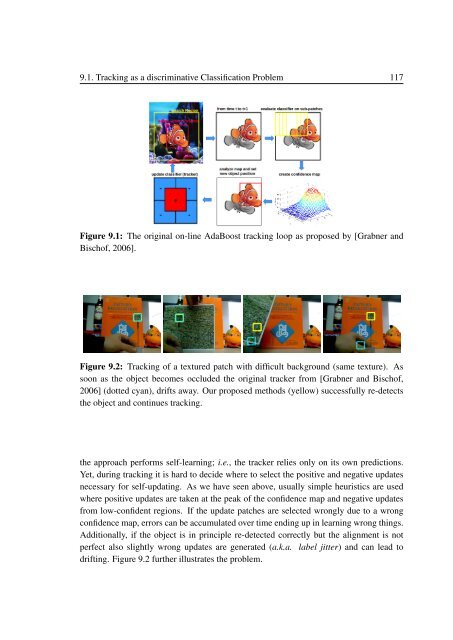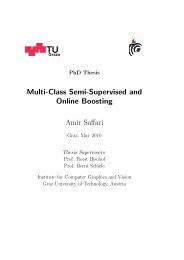PhD Thesis Semi-Supervised Ensemble Methods for Computer Vision
PhD Thesis Semi-Supervised Ensemble Methods for Computer Vision
PhD Thesis Semi-Supervised Ensemble Methods for Computer Vision
You also want an ePaper? Increase the reach of your titles
YUMPU automatically turns print PDFs into web optimized ePapers that Google loves.
9.1. Tracking as a discriminative Classification Problem 117<br />
Figure 9.1: The original on-line AdaBoost tracking loop as proposed by [Grabner and<br />
Bischof, 2006].<br />
Figure 9.2: Tracking of a textured patch with difficult background (same texture). As<br />
soon as the object becomes occluded the original tracker from [Grabner and Bischof,<br />
2006] (dotted cyan), drifts away. Our proposed methods (yellow) successfully re-detects<br />
the object and continues tracking.<br />
the approach per<strong>for</strong>ms self-learning; i.e., the tracker relies only on its own predictions.<br />
Yet, during tracking it is hard to decide where to select the positive and negative updates<br />
necessary <strong>for</strong> self-updating. As we have seen above, usually simple heuristics are used<br />
where positive updates are taken at the peak of the confidence map and negative updates<br />
from low-confident regions. If the update patches are selected wrongly due to a wrong<br />
confidence map, errors can be accumulated over time ending up in learning wrong things.<br />
Additionally, if the object is in principle re-detected correctly but the alignment is not<br />
perfect also slightly wrong updates are generated (a.k.a. label jitter) and can lead to<br />
drifting. Figure 9.2 further illustrates the problem.



